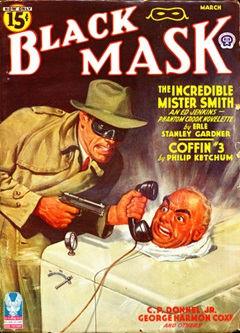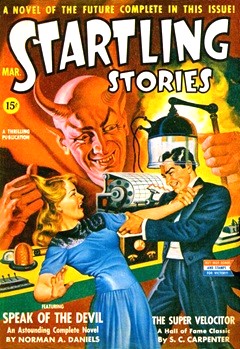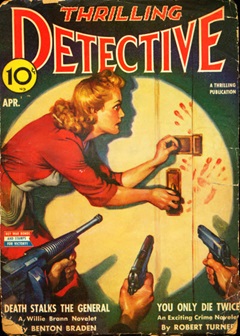Suspense is compounded of mystery and suspicion and dangerous adventure. In this series are tales calculated to intrigue you, to stir your nerves, to offer you a precarious situation and then withhold the solution… until the last possible moment when we again hope to keep you in…Suspense!
Suspense (1942-1962) aired “Fear Paints a Picture” on April 13, 1943 as the 37th of its 945 episodes.
As recounted in the introduction to the more than 50 episodes of Suspense we’ve shared over the past fourteen years, it was such a rich goldmine of superior stories that we found each one has had something unique to offer. Suspense was one of the most well produced, written, acted, and critically acclaimed of all radio shows during the Golden Age of Radio, many a film star jumping at the chance to perform in an episode, among them Cary Grant, Orson Welles, Jimmy Stewart, Susan Hayward, Vincent Price, Charles Laughton, Loretta Young, Peter Lorre, and Rita Hayworth. After many another radio show had gasped its last breath during the 1950s, Suspense (along with Yours Truly, Johnny Dollar) finally closed shop in September of 1962 whereupon radio historians proclaimed the Golden Age of Radio dead, television having become the medium of choice in America.
Written by well known author and playwright Sigmund Miller (1910-1998) and starring Hollywood actress Nancy Coleman (1912-2000, photo at top), “Fear Paints a Picture” is another example of the “someone is bequeathed an inheritance after a parent or other relative dies, but cannot claim it unless certain requirements are met” story. They are quite abundant in classic old time radio mystery and detective programs. The fun—after one has listened to a fair number of them (or read them or watched them on TV or at the movies)—is in discovering how clever, or even convoluted, another person’s (usually the next in line for the inheritance) scheme is, to insure the proper recipient of the inheritance is somehow removed from the scene (murdered being the most prevalent method if done cleverly), or that one or more of the requirements to be met for the inheritance never comes to pass. “Fear Paints a Picture” I wager is one of the more inventive, and yes, elaborate schemes to insure that young Julia Powell does not inherit her recently deceased father’s inheritance (which is quite large) at her upcoming 23rd birthday, and while her mother died a mad woman some years ago and she has come to live with her father’s friend Harvey Lyons in his large home, Julia is decidedly not exhibiting signs of the madness that took her mother, despite the living dreams that have recently come to terrorize her every night. So with her 23rd birthday a day or two hence and the recurring dreams frightening Julia out of her wits, how do mere dreams, nay even nightmares, become such a forceful reality that she is driven to entertain the possibility of taking her own life to rid herself of them? How indeed does it come to pass that “Fear Paints a Picture” is a fitting description of a bizarre scheme to force her out of her inheritance? The who and how are in play as the stage is set for a double revelation in this unusual treatment of the popular theme, one that has attracted the talents of many a story writer over countless decades, awaiting only each fresh iteration of which we feel this is one.
(The linked Suspense CD at top includes this episode and 11 others.)
Play Time: 29:36
{“Fear Paints a Picture” aired on a Tuesday evening in mid-April of 1943. As always, the neighborhood gang knew without making formal plans that they would meet at the corner newsstand the next day after school, knowing they would find stories of skullduggery, adventure, and danger awaiting them in some of their favorite magazines. Black Mask (1920-51) wore the undisputed mantle of royalty in the detective pulp genre, its history already somewhat legendary from the classic stories and authors it brought to its pages. It switched from a monthly to a bi-monthly in 1943 with the issue below. Startling Stories (1939-55) was one of the most colorful, adventure-oriented SF pulps of its time, placing its emphasis on wild imaginative fare over scientific accuracy. This formula paid off, as readers flocked to the magazine as many of their favorite authors took them to places beyond their wildest dreams. Many of its fanciful tales became beloved classics, whose stories would find homes in numerous collections in decades to come, while copies of the magazine would become collector items at science fiction convention huckster rooms, when they could be found. Startling Stories transitioned from a bi-monthly to a quarterly halfway through 1943, managing 5 issues. Thrilling Detective (1931-53) was a stalwart, rock-solid detective pulp, clocking in with an impressive 213 issues before it offered its final thrilling stories in the summer of 1953. It was a monthly in 1943, but after the war switched to a bi-monthly in 1946, the schedule it would faithfully maintain until becoming slightly erratic in its final two years.}
[Left: Black Mask, 3/43 – Center: Startling Stories, 3/43 – Right: Thrilling Detective, 4/43]



To view the entire list of weekly Old Time Radio episodes at Tangent Online, click here.

